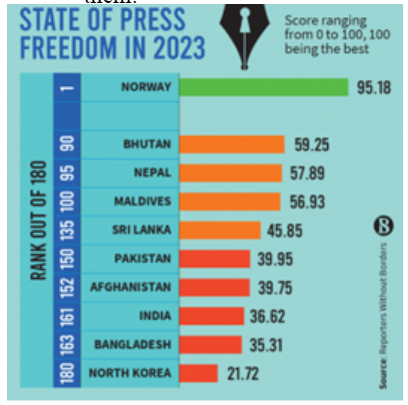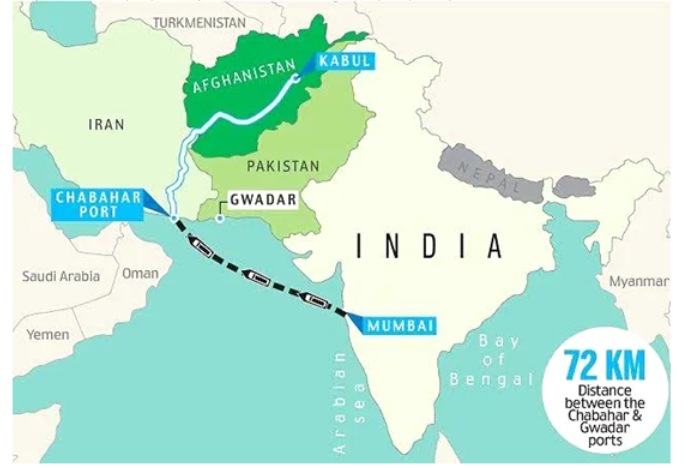Monday, 16th October 2023
Global Hunger Index 2023 - Edukemy Current Affairs
In News: India ranks 111th on the Global Hunger Index 2023.
About
India's rank in the 2023 Global Hunger Index is a cause for concern as it ranked 111th out of 125 countries, reflecting a significant level of hunger. Notably, India lagged behind neighboring countries like Pakistan (102nd), Bangladesh (81st), Nepal (69th), and Sri Lanka (60th) in terms of hunger-related indicators.
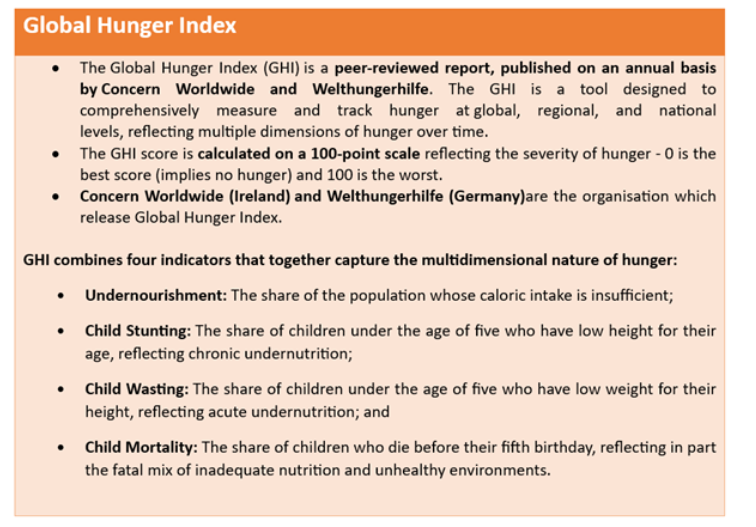
Highlight of Global Hunger Index 2023:
- India's GHI score 2023 stands at 28.7, categorized as "serious" on the GHI Severity of Hunger Scale. This shows a slight improvement from its GHI 2015 score of 29.2, which was also deemed serious.
|
Related Data and References:
|
Global Hunger Trends:
- The 2023 Global Hunger Index (GHI) report has highlighted the top-performing countries with low levels of hunger, which include Belarus, Bosnia & Herzegovina, Chile, and China. Whereas Yemen, Madagascar, and the Central African Republic find themselves at the bottom of the rankings, indicating a more severe hunger situation.
- The GHI score for the world in 2023 stands at 18.3, categorizing it as moderate, with limited improvement observed since 2015. Disturbingly, the prevalence of undernourishment has increased from 572 million to approximately 735 million people since 2017.
- This stagnation in progress can be attributed to a range of crises, including climate change, conflicts, economic shocks, the Covid-19 pandemic, and the Russia-Ukraine war. These crises have exacerbated social and economic inequalities and have acted as significant barriers to global efforts in reducing hunger.

Factor Responsible for Hunger in India
- Socioeconomic Disparities and Poverty: Widespread poverty and significant socioeconomic disparities are at the core of hunger in India. Poverty often leads to inadequate food consumption and the inability to afford essential nutritional and healthcare services, resulting in malnutrition and hunger.
- Hidden Hunger: India faces a severe issue of micronutrient deficiency, often referred to as hidden hunger. This problem arises due to poor dietary choices, diseases, and the failure to meet micronutrient needs, especially during pregnancy and lactation.
- Inefficient Agricultural Practices and Food Distribution: Inefficiencies in agricultural practices, including suboptimal crop yields and post-harvest losses, contribute to insufficient food availability. Additionally, issues in food distribution and supply chain management result in food scarcity and higher prices, disproportionately affecting the poor.
- Gender Inequality and Nutritional Disparities: Gender-based disparities further exacerbate the problem of hunger and malnutrition in India. Women and girls often have unequal access to food within households, receiving smaller portions or lower-quality diets. This inequity, coupled with the demands of maternal and child care, increases their vulnerability to chronic undernutrition.
- Climate Change and Environmental Stressors: India is susceptible to climate change-related environmental stressors, such as changing weather patterns, extreme weather events, and natural disasters. These environmental factors can disrupt agricultural production, leading to crop failures and food scarcity.

- Lack of Audit for Nutritional Programs: While various programs aimed at improving nutrition are planned in the country, there is often minimal or no mechanism for auditing the impact and effectiveness of these programs at the local governance level. This lack of oversight can hinder the success of initiatives designed to combat hunger and malnutrition.
|
UPSC CSE Previous Year’s Question (PYQs) Prelims (2016)
Q. Which of the following is/are the indicator/indicators used by IFPRI to compute the Global Hunger Index Report?
Select the correct answer using the code given below: (a) 1 only Answer: (c) Mains (2013) Q: Food Security Bill is expected to eliminate hunger and malnutrition in India. Critically discuss various apprehensions in its effective implementation along with the concerns it has generated in WTO. |
Surge in Human Settlements in Flood-Prone Areas
In News: Human settlements in some of the world's riskiest flood zones have grown by an alarming 122% since 1985, according to a recent World Bank study.
Key Highlights of the Study:
- Richer countries like the United States and parts of Europe are seeing more growth in safer areas than flood-prone ones. The United States saw dry settlements increase 76 per cent and the highest flood settlements go up only 46 per cent.
- Other countries with more dry settlements than ultra-wet areas include India, France, Sweden, Austria, Finland, Japan and Canada.
- China and Vietnam both saw their settlement extent more than tripling in the past 30 years, increasing far more than their dry land areas
- Most countries, especially in East Asia, saw more settlements in regular flood zones and ultra-high flood zones than in dry areas.
- Libya, which suffered from devastating flooding last month, had an 83 per cent increase in settlement extent in the worst flood zones.
- Pakistan, also affected by catastrophic flooding both last year and this year, had an 89 per cent increase.
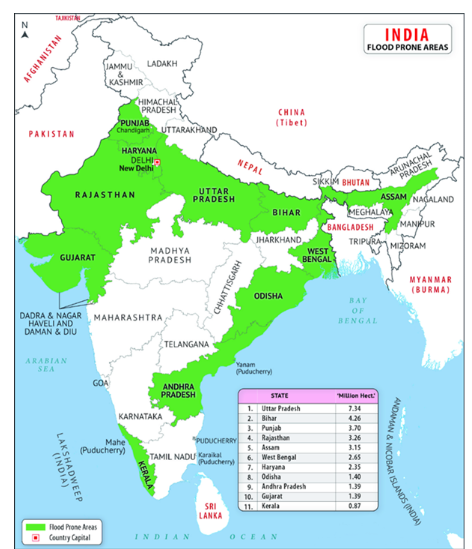
Reasons for these Settlements:
- As a nation grows a bit wealthier, there’s a change from rural to urban and people leave the country to go to cities, which are often near waterways that flood in places
- Initially people settle in a safe space, but as the city expands, it’s more likely to grow into areas that it previously avoided.
- People with low incomes sometimes lack financial resources to live in safer, less prone-to flooding-places. Due to residence cost restrictions, they can be compelled to reside in flood-prone areas.
- Coastal and riverbank locations continue to draw visitors and recreation enthusiasts due to their innate appeal, despite their vulnerability to floods.
- The demand for resorts, hotels, and vacation homes can lead to settlement in these areas, even if it's only seasonal.
Way Forward:
- Implement and enforce tight land use regulations that forbid or limit new buildings in floodplains with a high risk of flooding.
- Declare 'no-build' zones in flood-prone locations and rigorously enforce these limitations.
- Investments are required in floodplain mapping, stronger flood defences, early warning systems, and resilient infrastructure.
- Residents in flood-prone locations may be offered financial incentives by the government to move to safer places.
- To reduce the loss of life and property during flood occurrences, the government has to improve emergency response and preparedness measures in flood-prone regions.
- Encourage the development of community-based educational initiatives on flood preparedness and the significance of avoiding such locations.
|
UPSC CSE Previous Years Questions Mains Q. The frequency of urban floods due to high intensity rainfall is increasing over the years. Discussing the reasons for urban floods, highlight the mechanisms for preparedness to reduce the risk during such events. (2016) Q. Account for the huge flooding of million cities in India including the smart ones like Hyderabad and Pune. Suggest lasting remedial measures. (2020) Q. Major cities of India are becoming vulnerable to flood conditions. Discuss. (2016) |
Scheduled Areas in India - Edukemy Current Affairs
In News: Scheduled Tribes (STs) in India make up 8.6% of the country's population and are spread throughout several states and union territories. A crucial clause in the Indian Constitution's Article 244 governs the management of Scheduled and Tribal Areas.
Scheduled Areas and Scheduled Tribes:
- Scheduled Areas are designated in 10 states under the Fifth schedule and 4 States under the Sixth Schedule.
- The Fifth schedule states are Andhra Pradesh, Telangana, Odisha, Jharkhand, Chhattisgarh, Madhya Pradesh, Rajasthan, Gujarat, Maharashtra, and Himachal Pradesh.
- The Sixth Schedule states are Assam, Meghalaya, Tripura and Mizoram.
- Criteria for declaring an area as a Scheduled Area are:
- Significant tribal population
- Compactness Reasonable size
- Viability as an administrative entity
- Economic backwardness compared to neighbouring areas.
- The Constitution of India does not define the criteria for recognition of STs. As per Census-1931, STs are termed as "backward tribes” living in the "Excluded" and "Partially Excluded" areas.
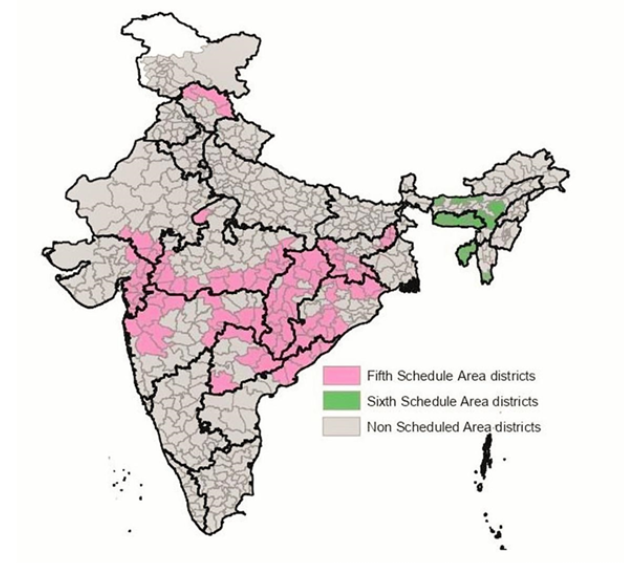
Constitutional Provisions:
- The Fifth Schedule provisions are applied to Scheduled Areas in states other than Assam, Meghalaya, Tripura, and Mizoram under Article 244(1). The Sixth Schedule is applied to the aforementioned states according to Article 244(2).
- The President of India notifies Scheduled Areas, and states with Scheduled Areas establish a Tribal Advisory Council to advise the Governor on ST welfare matters.
- Gram Sabhas are given significant power under the Panchayats (Extension to Scheduled Areas) Act (PESA) of 1996, which gives them direct democracy and prioritises local self-government.
- The Scheduled Areas of India are notified by the Indian President. A Tribal Advisory Council can have up to 20 ST members.
- They will advise the Governor on matters referred to them regarding ST welfare. The Governor will then submit a report every year to the President regarding the administration of Scheduled Areas.
Major Concerns Related to Scheduled Areas:
- In 1995, the Bhuria Committee, constituted to recommend provisions for the extension of panchayat raj to Scheduled Areas, recommended including these villages, but this is yet to be done.
- Even though Adivasi organisations have pushed for it, a substantial chunk (59%) of India's ST population is not included under Article 244, depriving them of protections provided by laws that are applicable to Scheduled Areas.
- They are denied rights under the laws applicable to Scheduled Areas, including the Right to Fair Compensation and Transparency in Land Acquisition, Rehabilitation and Resettlement Act 2013 and the Biological Diversity Act 2002.
Way Forward:
- All habitations or groups of habitations outside Scheduled Areas in all States and Union Territories where STs are the largest social group will need to be notified as Scheduled Areas irrespective of their contiguity.
- The geographical limit of these villages will need to extend to the ‘community forest resource’ area on forest land under FRA 2006 where applicable and to the customary boundary within revenue lands made possible through suitable amendments to the relevant State laws.
- The geographical limits of the revenue village, panchayat, taluka, and district will need to be redrawn so that these are fully Scheduled Areas.
|
UPSC CSE Previous Years Questions Prelims Q1. At the national level, which ministry is the nodal agency to ensure effective implementation of the Scheduled Tribes and Other Traditional Forest Dwellers (Recognition of Forest Rights) Act, 2006?
Answer: (d) Q2. Which Schedule of the Constitution of India contains special provisions for the administration and control of Scheduled Areas in several States? (2008)
Answer: (b) Q3. Under which Schedule of the Constitution of India can the transfer of tribal land to private parties for mining be declared null and void? (2019)
Answer: (b) Q4. The Government enacted the Panchayat Extension to Scheduled Areas (PESA) Act in 1996. Which one of the following is not identified as its objective? (2013)
Answer: (c) Q5. Under the Scheduled Tribes and Other Traditional Forest Dwellers (Recognition of Forest Rights) Act, 2006, who shall be the authority to initiate the process for determining the nature and extent of individual or community forest rights or both? (2013)
Answer: (d) Q6. The provisions in Fifth Schedule and Sixth Schedule in the Constitution of India are made in order to (2015)
Answer: (a) Mains Q. Article 244 of the Indian Constitution relates to the administration of scheduled areas and tribal areas. Analyse the impact of non-implementation of the provisions of the Fifth schedule on the growth of Left-wing extremism. (2013) Q. What are the two major legal initiatives by the State since Independence addressing discrimination against Scheduled Tribes (STs)? (2017) Q. Why are the tribals in India referred to as ‘the Scheduled Tribes’? Indicate the major provisions enshrined in the Constitution of India for their upliftment. (2016) |
Comprehensive Nuclear Test Ban Treaty
In News: Recently, Russia said that it might revoke its ratification to the Comprehensive Nuclear Test Ban Treaty (CTBT).
About:
- The CTBT is a multilateral treaty that bans all nuclear explosions, for both civilian and military purposes, in all environments.
- The roots of the CTBT can be traced back to the Cold War era when the United States and the Soviet Union were engaged in a nuclear arms race, conducting numerous nuclear tests.
- The treaty was adopted by the United Nations General Assembly in 1996.
- For the treaty to enter into force, it must be signed and ratified by 44 specific nuclear technology holder countries.
- But the eight of these 44 countries have not ratified the agreement yet. These eight countries are: China, Egypt, India, Iran, Israel, North Korea, Pakistan and the United States.
- The CTBT itself includes a Protocol in 3 parts.
- Part I detailing the International Monitoring System (IMS)
- Part II on On-Site Inspections (OSI)
- Part III on Confidence-Building Measures (CBMs)
Preparatory Commission for the Comprehensive Nuclear Test-Ban Treaty Organization (CTBTO):
- It is an international organization established by the States Signatories to the Treaty on 19 November 1996 and has its headquarters in Vienna, Austria.
- The objective of the organization is to achieve the object and purpose of the Treaty, to ensure the implementation of its provisions, including those for international verification of compliance with the Treaty and to provide a forum for consultation and cooperation among Member States.
https://indianexpress.com/article/explained/explained-global/nuclear-test-ban-treaty-ctbt-8971599/
Indian Pharmacopoeia Commission Joins PDG
In News: Recently, the Pharmacopoeial Discussion Group (PDG) announced the Indian Pharmacopoeia Commission (IPC) as a PDG member during PDG Stakeholder’s meeting in Hyderabad.
About:
Indian Pharmacopoeia Commission (IPC):
- It is an autonomous Institution of the Ministry of Health and Family Welfare.
- It is created to set standards of drugs in the country.
- Functions:
- Its basic function is to update regularly the standards of drugs commonly required for treatment of diseases prevailing in this region.
- It publishes official documents for improving Quality of Medicines by way of adding new and updating existing monographs in the form of Indian Pharmacopoeia (IP).
- It further promotes rational use of generic medicines by publishing National Formulary of India.
- It prescribes standards for identity, purity and strength of drugs essentially required from health care perspective of human beings and animals.
- It also provides IP Reference Substances (IPRS) which act as a fingerprint for identification of an article under test and its purity as prescribed in IP.
Pharmacopoeial Discussion Group (PDG):
- The PDG was established in 1989 by the European Pharmacopoeia (Ph. Eur.), the Japanese Pharmacopoeia (JP), and the US Pharmacopeia (USP).
- The World Health Organization joined it as an observer in 2001.
- Objective: To reduce the challenges faced by drug manufacturers who have to conduct tests differently and meet various quality standards to comply with drug regulations that vary from country to country.
Benefits of IPC as PDG Member:
- Enhances the international visibility and recognition of the Indian Pharmacopoeia.
- Leads to the production of high-quality pharmaceutical products that meet global standards benefiting both domestic and export markets.
- This collaboration will help India in aligning its regulatory processes and practices with global standards, making it easier for Indian pharmaceutical companies to comply with international regulations.
- Helps reduce trade barriers and facilitate the global trade of pharmaceutical products.
- Helps improve the acceptance of Indian medicinal products in global markets.
- The harmonization of pharmacopoeial standards among PDG members will contribute to the global effort to ensure the safety and efficacy of marketed pharmaceutical products.
More Information:
IPC was the only Pharmacopoeia body in the world to be selected for the pilot phase initiated in September 2022. After a year-long pilot phase, IPC's inclusion as a permanent PDG member was confirmed in September 2023.
Phonotaxis Phenomenon - Edukemy Current Affairs
In News: Recently, it has been discovered that certain creatures like Insects, Bats exhibit positive and negative phenomena of Phonotaxis in response to the existing environmental and anatomical conditions.
About:
- Scientists call phonotaxis as the movement by an animal in response to a sound.
- It has mostly been observed among crickets, moths, frogs, and toads, among a few other creatures.
- Types: There are two types of phonotaxis
- Positive phonotaxis:
- The purpose of positive phonotaxis is attraction.
- It usually happens when the females of a particular species – including those of crickets and frogs – are attracted to the sounds made by the males.
- Negative phonotaxis:
- It serves to repel or warn, such as when the sound of a predator nearby signals to an animal that it needs to move away.
- Crickets in particular have been found to steer themselves away from low-intensity ultrasound typically associated with bats (which use it for echolocation).
- Positive phonotaxis:
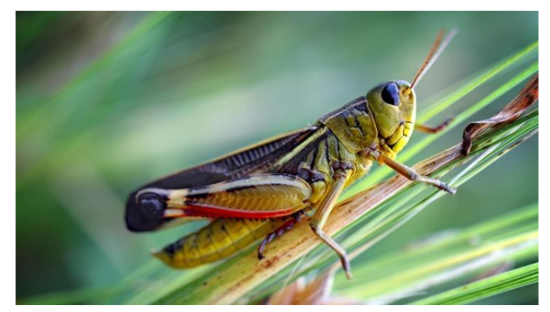
https://www.thehindu.com/sci-tech/science/phonotaxis-first-sound-then-motion/article67396049.ece
USS Gerald R Ford - Edukemy Current Affairs
In News: In light of recent conflict escalation in Israel, the US has deployed the USS Gerald R Ford carrier strike group (CSG) to the Eastern Mediterranean, demonstrating its support for Israel and the carrier's role in military operations.
About:
- USS Gerald R Ford is US Navy’s newest and most advanced aircraft carrier.
- The ship is named after the 38th President of the United States, Gerald Ford, who served from 1974 to 1977.
- It was commissioned in 2017.
- The USS Gerald R. Ford (CVN 78) is a first-in-class aircraft carrier.
- First-in-class technology includes a new nuclear plant, the ability to generate nearly three times the amount of electrical power, innovative advanced arresting gear, and the electromagnetic aircraft launch system (EMALS).
- It is considered as one of the largest warships ever constructed.
- It displaces 100,000 tonnes at full load.
- It can achieve a top speed of over 30 knots, equivalent to 56 kilometers per hour.
- It has the capacity to hold around 4,660 crew members.
- It can carry more than 75 aircrafts.
- It comes with a slew of surface-to-air missiles, including the RIM-7 Sea Sparrow, and the RIM-116, and M2 machine guns.

Passport to Earning (P2E) Initiative
In News: UNICEF’s Passport to Earning (P2E) Initiative has achieved a significant milestone by certifying over one million young people in India in the areas of financial literacy and digital productivity.
About:
- P2E is an e-learning solution, launched in 2022, by UNICEF India, YuWaah and partners.
- This initiative aligns with the National Education Policy and provides free access to certificate courses in digital productivity, financial literacy, employability skills, and other in-demand, job-ready skills.
- It aims to empower 5 million youth between the ages of 14-29 with skills (by 2024) and connect them to job and self-employment opportunities to achieve financial independence.
- Notably, 62% of the beneficiaries of P2E courses in India are adolescent girls and young women.
- It was celebrated during an event on the UN International Day of the Girl Child (11th October)
- Mode of Learning: It provides learning options in online, hybrid, and offline models.
Gaza Strip - Edukemy Current Affairs
In News: Recently, After Hamas militants launched the biggest assault on Israel in decades, the country’s defence minister ordered a “complete siege” of the Gaza Strip.
About:
- The Gaza Strip is situated in the eastern Mediterranean basin, sharing borders with Egypt in the southwest and Israel to the north and east. To the west, it is bounded by the Mediterranean Sea.
- It is one of the most densely populated areas globally, with over 2 million residents living in a tiny area.
- The population is predominantly Palestinian, with the majority being Sunni Muslims.
- Hamas, a Palestinian Islamist organisation, currently governs the Gaza Strip.
- It took control in 2007 after it won elections there the year before. Since then, no elections have been held.
- This move has highlighted the long-standing and contentious issue of the Gaza blockade, which has been in place since 2007.
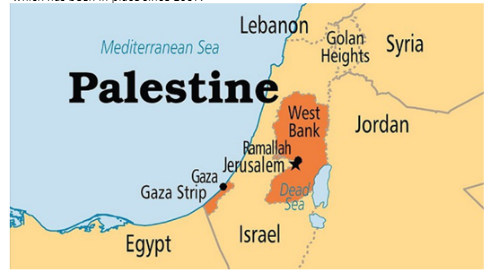
The power of green methanol - Edukemy Current Affairs
Exam View: Laura Maersk; What are green methanol’s advantages over conventional fuels? What are the concerns regarding green methanol? Global initiatives; Domestic initiatives.
Context: The Laura Maersk is the world’s first green-methanol-run freight vessel. NITI Aayog believes green methanol can be used to power rail, road and shipping.
Decoding the editorial: The Laura Maersk Container ship
- It is a 2,100-tonne container ship that will sail around the Baltics and is the world’s first green-methanol-run freight vessel.
- Launched by the EU Commission President, it is a significant addition to the giant Maersk shipping line’s 700-strong fleet.
- Maersk originally planned to launch its first green ships only by 2030 so it’s now seven years ahead of schedule.
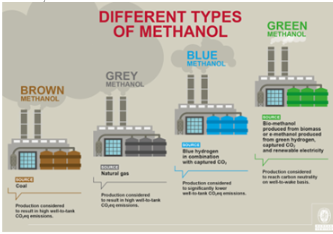
- It is the beginning of a green revolution in global supply-chains.
What are green methanol’s advantages over conventional fuels?
- Green Methanol is a methanol produced from renewable sources and without polluting emissions, such as green hydrogen.
- It’s an available technology with a scalable solution which helps in pollution control.
- Highly polluting container ship fuels contribute 3% of global carbon dioxide emissions.
- Green methanol can reduce CO2 emissions by up to 95% and nitrogen oxide by 80%.
- Also, it eliminates sulphur-oxide and particulate matter emissions.
- Crucially for the shipping industry, it can be transported and used at room temperatures.
- Blending of 15% methanol in gasoline can result in at least 15% reduction in the import of gasoline/crude oil.
- NITI Aayog believes it can be used to power rail, road and shipping. Besides that, it reckons it can partially replace LPG for cooking.
Benefits of Methanol:
- Cost-Effective Production: Methanol Offers a More Affordable Fuel Alternative for a Range of Applications.
- Environmental Advantages: Utilising Green Hydrogen and Carbon Capture in Methanol Production yields reduced greenhouse gas emissions and cleaner air. A sustainable choice for fuel and energy.
- Emission Management: Incorporating water in methanol combustion facilitates compliance with stringent emission standards, including Tier III for NOx. It is an effective solution for emission control in various applications.
- Ease of Handling and Transport: Methanol offers convenient management and transportation within standard temperature and pressure parameters.
- Flexible Applications: Methanol's versatility as an engine fuel extends to dedicated methanol engines. Its applicability extends to shipping, aviation, engine waste heat fuel reforming, and industrial power generation.
What are the concerns regarding green methanol?
- Green-methanol production is still low, with less than 0.2 million tonnes produced annually.
- Methanol production costs are significantly higher and won’t beat fossil fuels in price until capacity starts to catch up.
Global initiatives
Cargo and container fleets run mainly on dirty diesel-based bunker fuels. It’s estimated there are some 100 green methanol-powered ships already ordered across the industry.
- Maersk’s initiatives:
- Maersk aims to achieve net-zero greenhouse gas emissions by 2040.
- Maersk has formed a joint venture, C2X, that will develop and run production facilities.
- Maersk has tied up with Norwegian company, Equinor, to keep the Laura Maersk on the high seas.
- In the US, it has struck a deal with a company, Carbon Sink, to supply the fuel at different ports.
- China’s initiatives:
- Chinese shipping company Cosco has ordered 12 green-methanol ships.
- Cosco has tied up with three other firms, including the Shanghai International Port Group, to create what it calls a green-methanol industrial chain.
- China is looking at green methanol to power everything from automobiles to trucks and public transport, aware that carbon-neutral fuel could help them to achieve climate targets.
Domestic initiatives
- Umwelt, a Danish company, has plans for an $850-million Tamil Nadu plant to produce 100,000 tonnes of green methanol annually.
- In Madhya Pradesh, a company, Jakson Green, has tied up with NTPC for a methanol facility at the Vindhyachal Thermal Power Plant.
- Maersk is looking at all elements of its logistics chain. In India, it has a fleet of electric-powered three-wheelers and small vans.
Share the article
Edukemy’s Current Affairs Quiz is published with multiple choice questions for UPSC exams
MCQ
Get Latest Updates on Offers, Event dates, and free Mentorship sessions.

Get in touch with our Expert Academic Counsellors 👋
FAQs
UPSC Daily Current Affairs focuses on learning current events on a daily basis. An aspirant needs to study regular and updated information about current events, news, and relevant topics that are important for UPSC aspirants. It covers national and international affairs, government policies, socio-economic issues, science and technology advancements, and more.
UPSC Daily Current Affairs provides aspirants with a concise and comprehensive overview of the latest happenings and developments across various fields. It helps aspirants stay updated with current affairs and provides them with valuable insights and analysis, which are essential for answering questions in the UPSC examinations. It enhances their knowledge, analytical skills, and ability to connect current affairs with the UPSC syllabus.
UPSC Daily Current Affairs covers a wide range of topics, including politics, economics, science and technology, environment, social issues, governance, international relations, and more. It offers news summaries, in-depth analyses, editorials, opinion pieces, and relevant study materials. It also provides practice questions and quizzes to help aspirants test their understanding of current affairs.
Edukemy's UPSC Daily Current Affairs can be accessed through:
- UPSC Daily Current Affairs can be accessed through Current Affairs tab at the top of the Main Page of Edukemy.
- Edukemy Mobile app: The Daily Current Affairs can also be access through Edukemy Mobile App.
- Social media: Follow Edukemy’s official social media accounts or pages that provide UPSC Daily Current Affairs updates, including Facebook, Twitter, or Telegram channels.


